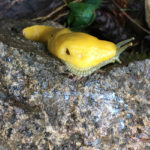“Water vapor is your enemy, heat is everything, and there is always another step,” says Sean. He runs a bronze foundry in Santa Cruz.
Bronze casting is a messy, multi-step process that pulls beauty from chaos. And Sean is a chemist, a material engineer, and an artisan.
I followed Sean’s work this week as he recreated a plaster sculpture in bronze. The plaster piece had been used as a decorative feature in a fountain, and it was melting away despite the sealant someone had applied to its exterior years ago. The people who owned the fountain had grown to love the piece, a Greek godlike face they called “Eliot.” And they could not bear to say good-bye.
Eliot was in a bad state, so Sean had to restore some of his features using an oil-based clay before he could begin the casting process.
Then Sean painted Eliot with a quarter-inch-thick layer of liquid rubber, and shellacked it with final coating of plaster – a hard, protective cast. Once the rubber dried, Sean carefully extracted the original Eliot made of clay, leaving behind a perfect rubber negative of Eliot’s image.
The next step was to create a new Eliot in wax using the rubber
mold. Sean heated the blood-red wax to its liquid state and poured it into the rubber-lined form, carefully swirling each coat to ensure a consistent thickness. It took only 20 minutes for the wax to cool and then he peeled away the rubber mask from Eliot’s waxen twin.
Sean then dipped the waxen Eliot in nine coats of plaster with a generous peppering of
sand between each layer. And two days later, he baked Eliot and several other soon-to-be-bronze pieces in a kiln at 1,800 degrees for about half an hour.
The kiln cures the ceramic shell and prepares it to receive the 2,000-degree bronze that will be poured into it the next day. The kiln also melts away Eliot’s waxy interior leaving a hollow space shaped like Eliot’s face inside of the ceramic hull. If any water vapor is left trapped in the pores of the ceramic at this stage, it will expand when the bronze is poured later and destroy all of Sean’s hard work.
It takes two men to pour the molten bronze. Sean and his assistant each hold one end of the giant tongs that grip a glowing hot crucible filled with lava-hot metal. Eliot requires what Sean calls a medium high heat. Other pieces with longer, narrower, limb-like features would require higher heat.
what Sean calls a medium high heat. Other pieces with longer, narrower, limb-like features would require higher heat.
The temperature has to be just right. Too cool, and the bronze will not reach all the nooks and crannies. Too hot, and you risk uneven cooling, especially in thicker sculptures.
Eliot’s ceramic mold is buried upside down in a bucket of sand with only its 3-inch diameter opening exposed. The sand holds Eliot’s cast steady and counters the hydraulic pressure inside as the men pour the bronze. They work quickly and steadily – avoiding bubbles, but working fast enough that the metal does not have time to cool and thicken prematurely.
In less than half an hour, the bronze has taken its final form and
Eliot is ready for his debut. Sean hammers, then chisels, and then sandblasts the figure until it is smooth and tan with a flat finish.
The final patina is achieved with a flourish of flame and chemicals followed by a quick sanding to highlight Eliot’s regal features.
And as Sean said, there is always another step.
Tomorrow morning, I’ll accompany him to the final installation. Eliot, in his bronze glory, will be mounted on the garden wall where his plaster sibling once hung. And once the fountain’s water has returned to frame Eliot’s face in trickles and streams, we’ll toast his return with friends and family who have gathered in his honor.
















Comments are closed.